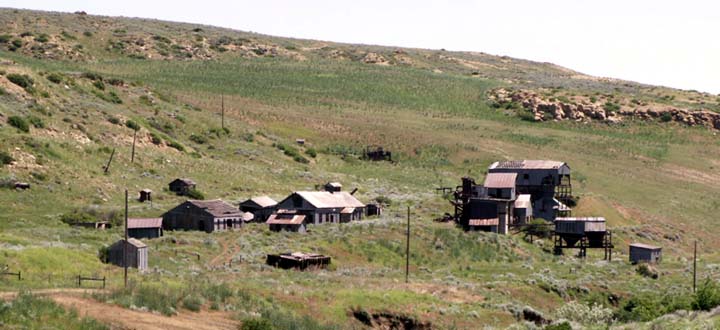|
Smith Mine Disaster in 1943

A sign posted along the highway a few miles east of Red Lodge tells of the disaster that happened at this mine in the winter of 1943 . . . Smoke pouring from the mine entrance about 10 o’clock in the morning of February 27, 1943, was the first indication of trouble. “There’s something wrong down here. I’m getting out,” the hoist operator called up. He and two nearby miners were the last men to leave the mine alive.
Rescue crews from as far away as Butte and Cascade County worked around the clock in six-hour shifts to clear debris and search for possible survivors. There were none. The night of March 4, workers reached the first bodies. More followed until the toll mounted to 74. Some died as a result of a violent explosion in the No. 3 vein, the remainder fell victim to deadly methane gases released by the blast.
The tragedy at Smith Mine became Montana’s worst coal mine disaster, sparking investigations at the state and national level. Montana Governor Sam C. Ford visited the scene, offered state assistance and pushed a thorough inquiry into the incident.
Today’s marker of the Smith Mine Disaster follows a simpler one left by two of the miners trapped underground after the explosion, waiting for the poisonous gas they knew would come. Good-bye wives and daughters. We died an easy death. Love from both of us. Be good.
Walter & Johnny.
The aftermath . . .
Several weeks after the disaster, a coroner’s inquest involving witnesses and mine bureau investigators concluded that some of the men died from concussion caused by a gas and dust explosion, while others fell victim to gas poisoning. The disaster had a huge impact on nearby communities of Bearcreek Washoe, and Red Lodge. Fifty-eight women lost their husbands and 125 children became fatherless, including six of eight students in the senior class at Bearcreek High School. The disaster brought an end to the local coal mining industry despite the fact that thousands of tons of coal remain beneath the arid hills. The towns of Bearcreek and Washoe all but vanished as homes were torn down, abandoned, or moved to nearby Red Lodge or Belfry. (source: Historian Bill Cenis, Town of Bearcreek)
Coal Use Then and Now . . .
Today over 90% of the coal used in the United States is burned to generate electricity, with the next biggest share used in the production of steel. At the time of the Smith Mine disaster, coal was not used to generate electricity, but it did have many other uses that were important to the American way of life. One of the primary uses was for heating homes and other buildings. Coal trucks made regular deliveries to houses that were kept warm by coal-burning stoves, often located in basements. Coal also fueled the smelters that removed copper and silver from ores mined in the western part of the state. Large quantities were also used to power the railroad trains that shipped goods and people across the country. Their locomotives burned coal until 1950 when diesel engines replaced steam engines, causing a drastic decrease in the demand for coal at that time. Coal’s other early uses have gone by the wayside as well, replaced by cleaner burning, more efficient fuels. Today the demand for coal is kept high by the demand for electricity to run our iPods, cell phones, video games, computers, televisions and other electronic devices.
Coal Mining Then and Now . . .
In the early 1900s there were many coal mines scattered in small towns across central and eastern Montana. Along with Bearcreek, Red Lodge, and Washoe, other communities such as Roundup, Klein, Belt, and Sand Coulee were also coal-mining towns. A big difference between coal mining in Montana at the time of the disaster and mining in recent decades is that “strip mining,” rather than underground mining, has been used to remove the vast majority of coal mined in Montana since 1970. With strip mining, layers of rock above the coal are removed to reach the seams of coal, and all of the work is done from the surface by large equipment operated by a few miners. Although it provides fewer jobs, strip mining is much safer because workers do not have to go underground where collapses, gas explosions, and lung diseases are risks. Click here to learn more about strip mining in Montana.
Term: "dust explosion"
|





